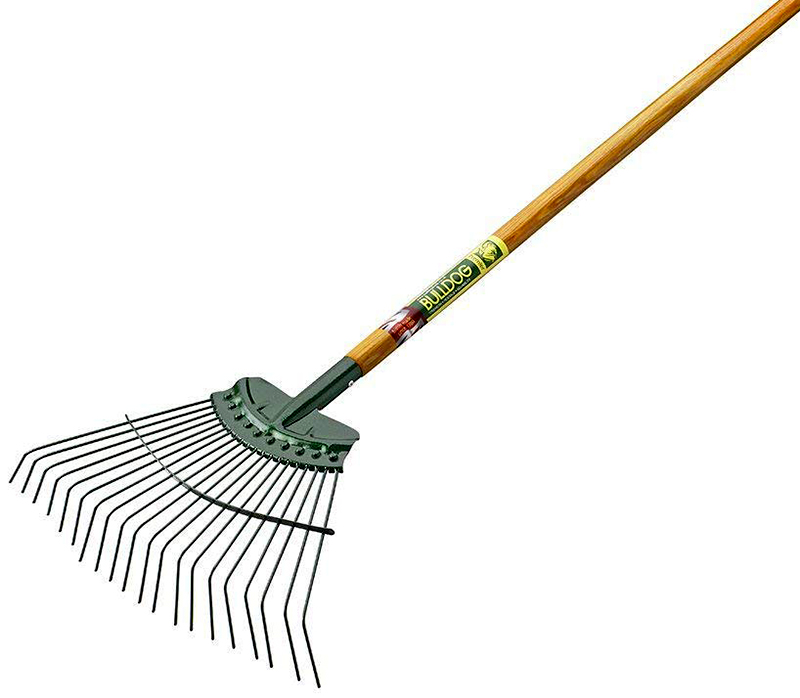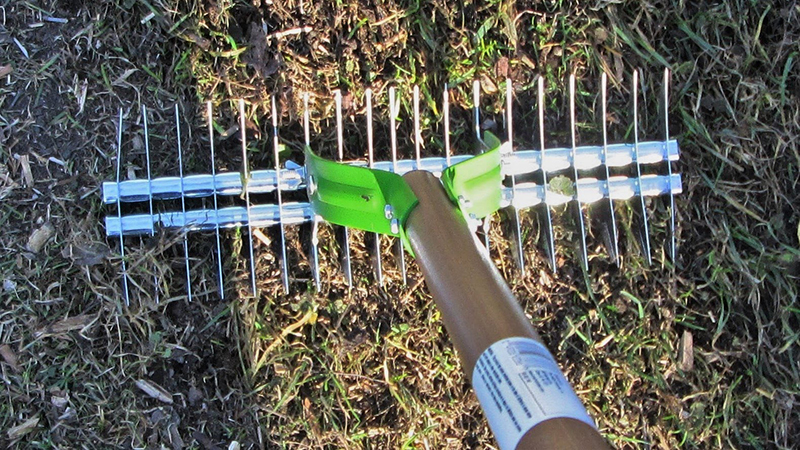
Rakes seem straightforward but not all are created equal. Rakes on the farm include garden, bow, landscape, level head, lawn types and more. Knowing which one to use takes a bit of knowledge.
Walking into a hardware store, it’s easy to be overwhelmed by the array of rake availability, and each is designed for a specific range of tasks. Knowing how to select the correct rakes for your needs will save time and make your physical labor more efficient.
Garden Rakes
The catch-all category of “garden rakes” or “steel rakes” (pictured above) encompasses a number of rake designs that rely on short sturdy tines for a wide range of cultivation and clearing tasks. There are three broad styles of garden rakes.
Bow
The bow rake is a common workhorse that features 14 to 16 vertical or curved tiånes arranged in a straight alignment that is offset from a long handle by a pair of curved bows extending from both sides of the head. Used for a number of garden tasks, the bow rake is especially good for spreading mulch, weed removal, tamping soil, breaking up compacted soil clods, and removing roots and rocks from cultivated beds. The bow design gives the rake efficient spring action.
Landscape
The landscape rake is a general term for a larger level head-type rake. These broad rake heads range in width from 20 to 36 inches, and because of their size, the heads and handles are often composed of lighter materials, such as aluminum. Rakes of this size are intended to be used to level wide areas of cultivated soil and to easily spread large volumes of sand or earth.
Level Head
Similar in appearance and function to the bow rake, level head (aka flathead) rakes feature a head with a row of straight or curved tines connected directly to the handle. Level head rakes can be used for similar tasks as the bow rake but are especially good at breaking up spaded soil and eliminating debris. After the soil is turned and cleared, the rake head can be flipped upside down and used to smooth or level earth. Unlike the relatively standardized bow rake, level head rakes can be found in different head sizes with various spacing and length of the rake teeth for different cultivation and bed preparation needs. For example, level head rakes with closely spaced teeth are designed for fine preplanting soil cultivation compared to rakes with wider spacing between their teeth which are used for rough initial clearing and large debris removal. Some ingenious manufactures have also designed rubber covers to be slipped on several rake teeth in order create deeper planting furrows at a set spacing.
Lawn Rakes

Lawn rakes are crucial tools for collecting organic litter from open space. While primarily used in manicured formal landscapes, lawn rakes are also essential for gathering leaves and grass to be used for homemade compost or mulches. There are two main styles of lawn rakes:
- fan-shaped: made of plastic or bamboo
- spring-type: made of flexible steel tines with a tension bar
Of the two, spring-type leaf rakes are the most durable and versatile, making them a good choice for most light cleanup work. If you have concerns about damage to underlying tender plants, bamboo or plastic rakes may be a better choice. There are also unique lawn rakes available with adjustable heads that can be narrowed for raking in tight spaces or scooping heads that can be used to pick up raked materials.
Lawn rakes are lightweight and feature a multitude of fine teeth which makes them ideal for quickly gathering large quantities of light organic debris. This task is unsuited for their garden-rake cousins due to the inefficiency and clogging issues of the heavy tines.
Specialty Rakes
A number of very specialized single-task rakes are also available on the market, including thatch or scarifying rakes, rubber rakes and rock rakes.
Thatch

Thatch varieties look unusual and feature a series of closely spaced large curved tines on an adjustable head. They are used to remove excess dead grass and other organics near the surface of the soil, known as thatch, which allows more air and moisture flow for healthier lawns.
Rubber

With a head full of soft flexible tines, rubber versions are designed to safely remove leaves and debris from brick or stone surfaces that might be scratched or damaged by traditional lawn rakes.
Rock

Finally, specialized rock tools are used to collect stones from rocky soils that have already been tilled. While designs for rock rakes vary, most have a curved U-shaped design that allows you to rake cultivated soils for rocks and then flip the head to winnow out any remaining soil before relocating the stones out of the garden.
Purchasing Advice
The quality of the tools sold in big-box hardware stores and even local hardware shops tends to be poor, consisting primarily of mass-produced tools made of low-grade materials. While these are often initially serviceable, they tend to last only a season or two before starting to break or fall apart. Take the time to find higher quality rakes and hand tools that feature sturdy materials and thoughtful ergonomic designs.
For traditional bow or level head rakes, look for forged steel heads rather than rake heads made of stamped, hardened or cast steel. Forging is the strongest and most labor-intensive of the steel-manufacturing processes and produces a denser end product, which holds a better edge. It also has slight flexibility that adds to the durability of the tools by helping prevent breakage.
Beyond the heads of the tools, consider the type of handle. Good hardwood handles (traditionally ash or hickory) are my preferred choice, though some may prefer fiberglass handles, as they’re lighter and require less cleaning and care. Whichever handle type you choose, be sure that it’s firmly connected to the head. Finally, be sure to select a tool with a long handle so it can be used by people of any height without back strain.
Expect to pay three or four times more for a well-crafted rake than you would for a low-grade hardware store rake. The upside to the high costs is that, when well-cared for, these tools truly are lasting and can even be passed down to the next generation of farmers and gardeners.
This article about rakes was written for Hobby Farms magazine. Click here to subscribe.




